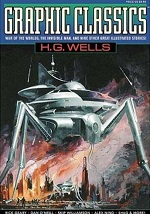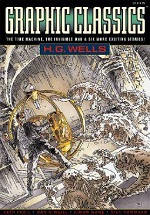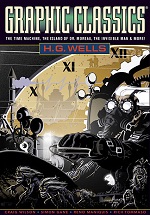|  
 
 | | | |  1st edition 1st edition

 2nd edition 2nd edition

 3rd edition 3rd edition

| | Graphic Classics: H.G. Wells
by Nicola Cuti, Antonella Caputo, Seth Frail and Craig Wilson
First publication: Graphic Classics 3 (1st Edition), Aug 2002

 Eureka publishers have released a series of Graphic Classics trade paperbacks, each issue of which collects together comic book versions of stories, usually from a single classic author such as Edgar Allan Poe, Arthur Conan Doyle, H.P. Lovecraft, Jack London, and more. And, yes, the series includes an H.G. Wells issue (#3) which has undergone three editions, each of which has presented new black and white Time Machine material. Eureka publishers have released a series of Graphic Classics trade paperbacks, each issue of which collects together comic book versions of stories, usually from a single classic author such as Edgar Allan Poe, Arthur Conan Doyle, H.P. Lovecraft, Jack London, and more. And, yes, the series includes an H.G. Wells issue (#3) which has undergone three editions, each of which has presented new black and white Time Machine material.

My favorite is the Wilson version (3rd edition), which has a steampunkish Eerie Comics feel and an extended stand-alone version with ten additional pages. My- 1st edition (Aug 2002) A Time Machine Portfolio by Nicola Cuti
- 2nd edition (Apr 2005) The Time Machine by Antonella Caputo and Seth Frail
- Stand-alone (Jun 2013) The Time Machine by Caputo and Craig Wilson
- 3rd edition (Feb 2014) The Time Machine by Caputo and Craig Wilson
 I cannot help but wonder. Will he return? It may be he was swept back into the past. Or did he go forward into one of the nearer ages, when men are still men, but with the wearisome problems of our own age solved? I may never know. I cannot help but wonder. Will he return? It may be he was swept back into the past. Or did he go forward into one of the nearer ages, when men are still men, but with the wearisome problems of our own age solved? I may never know. 

—from Caputo’s adaptation
| |
| | | | |

| |     |